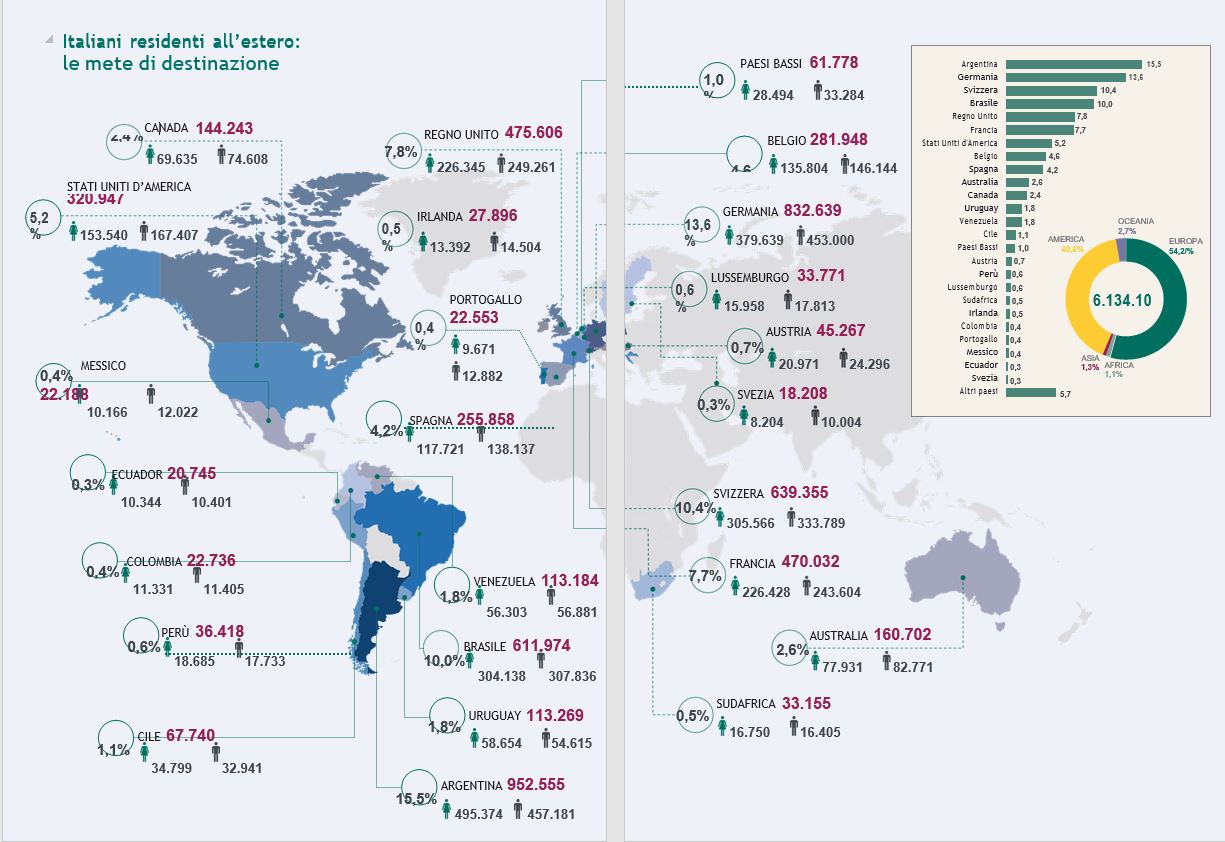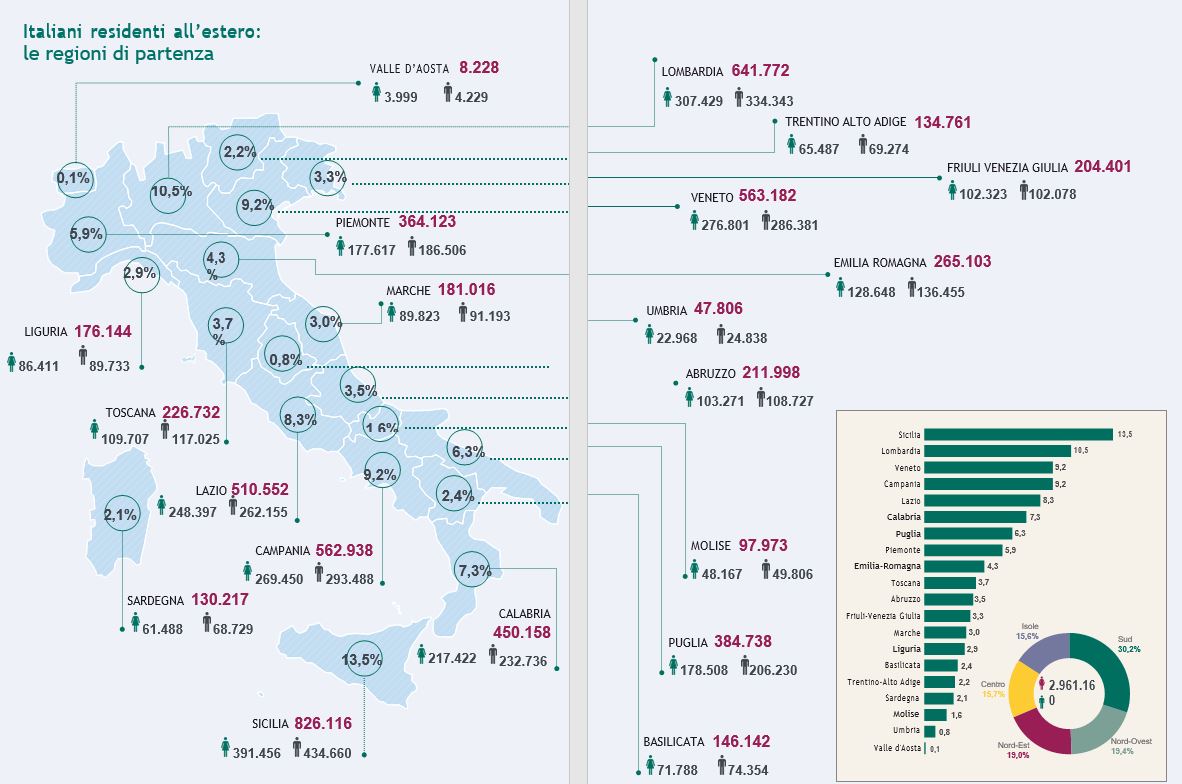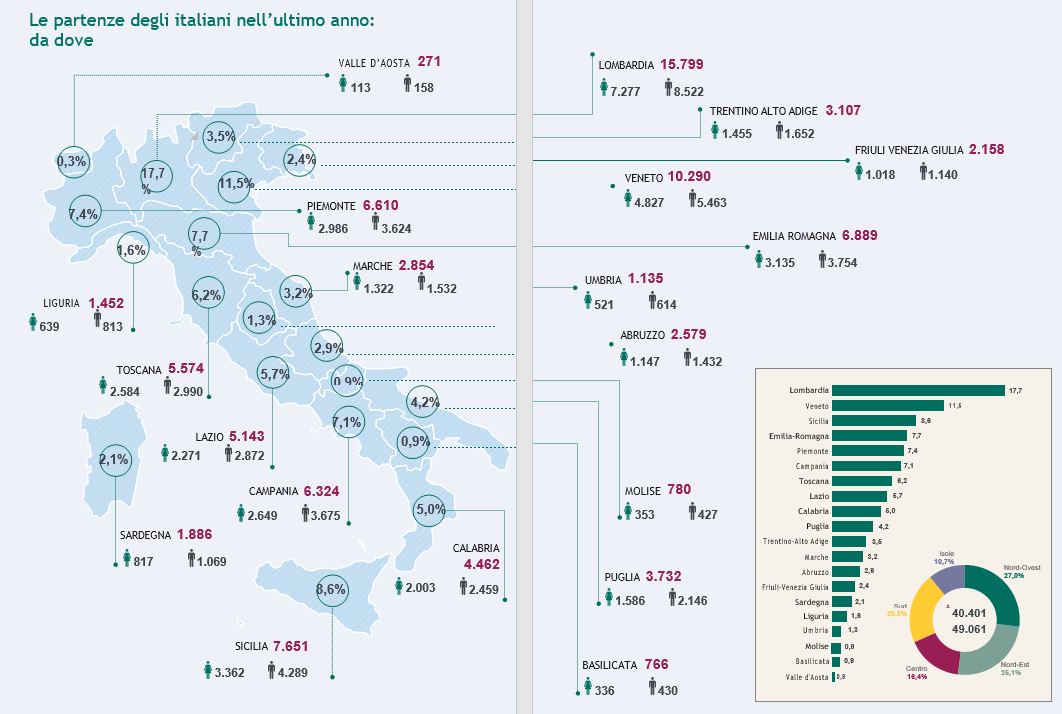
A total of 6 million 134 thousand Italian citizens live abroad: the only Italy that continues to grow. As many as 89,462 Italians moved abroad in 2023, 9.1% more than in 2022, although this figure is still below pre-pandemic levels. Young people, young adults and the over 65s are emigrating. The “new Italians”, i.e. immigrants who acquired Italian citizenship, are increasingly relocating to other European countries. Citizenship acquired by descent is soaring. Even Italians are moving several times between countries or returning home: but Decree-Law 209/2023, which reduces tax benefits, is likely to discourage the return of families and young people in particular. These are some of the details contained in “Rapporto Italiani nel mondo 2024” (Italians in the World in 2024), published by the Migrantes Foundation and curated by Delfina Licata. The volume also includes a special section on citizenship.
More than half the total number of Italians abroad relocated to European countries. In 2024, out of a total of 6.1 million people registered with AIRE (the Registry of Italians living abroad), 54.2% lived in Europe (over 3.3 million, including over 2.5 million in the EU-15), 40.6% in America (over 2.4 million, including 2 million in Central and South America), over 167,000 in Oceania (2.7%), over 78,000 in Asia (1.3%) and 70,000 in Africa (1.1%).
 Most immigrants from Sicily, Lombardy and the Veneto region. In 2024, Sicily was still the region with the largest community of citizens registered in the AIRE (+ 826 000), followed by Lombardy (+ 641 000) and Veneto (+ 563 000). Southern Italy (over 2.8 million, of which 956 thousand in Sicily) accounted for 45.8% of those registered with the AIRE. More than 2.3 million originally lived in Northern Italy. 966 thousand left from Central Italy (15.7%).
Most immigrants from Sicily, Lombardy and the Veneto region. In 2024, Sicily was still the region with the largest community of citizens registered in the AIRE (+ 826 000), followed by Lombardy (+ 641 000) and Veneto (+ 563 000). Southern Italy (over 2.8 million, of which 956 thousand in Sicily) accounted for 45.8% of those registered with the AIRE. More than 2.3 million originally lived in Northern Italy. 966 thousand left from Central Italy (15.7%).
 Age diversity. 23.2% of Italians living abroad were in the 35-49 age bracket, 21.7% were in the 18-34 age group and 19.5% were in the 50-64 age group. Among those living abroad, 14.6% were minors, while 21.0 % were senior citizens, 9.5% of whom were aged 65-74, 6.7% were aged 75-84 and 4.8% were over 85.
Age diversity. 23.2% of Italians living abroad were in the 35-49 age bracket, 21.7% were in the 18-34 age group and 19.5% were in the 50-64 age group. Among those living abroad, 14.6% were minors, while 21.0 % were senior citizens, 9.5% of whom were aged 65-74, 6.7% were aged 75-84 and 4.8% were over 85.
Of 89,462 Italians who registered with AIRE in 2023 on the grounds of “expatriation“, 54.8% were male, 66.9% single, 26.9% married and 0.3% in a civil union. 45.5% of the total were aged 18-34, 5.5% were over 65.
The number of people aged 65 and over increased by 12.9%, with the largest increase (+14%) in the 65-74 age group.
Adolescents and young adults as a whole (68.8%) make up the largest group of Italian expats, followed by 14.7% of minors (over 13,000) and 5.5% of people over 65 (around 5,000). The remaining 11.1% are in the 50-64 age group. Europe was the destination chosen by 71.4% of Italians who emigrated in the period January-December 2023 (almost 64 thousand Italian nationals). Italians expatriated from all Italian provinces to 187 countries worldwide across all continents.
 Among the growing number of Italians aged 65 and over (+12.9%), some are returning to the country they emigrated to years ago, where their grandchildren were also born; others are returning to spend time as grandparents or grandmothers, to be close to their children and take care of their grandchildren; others are leaving Italy for the first time, while some decide to move abroad to improve their standard of living and pay less taxes. Briefly, “there are five factors influencing Italian seniors’ decision to move abroad. These are: the mild weather, the taxation system, public healthcare, the cost of living and cultural vibrancy,” the report says.
Among the growing number of Italians aged 65 and over (+12.9%), some are returning to the country they emigrated to years ago, where their grandchildren were also born; others are returning to spend time as grandparents or grandmothers, to be close to their children and take care of their grandchildren; others are leaving Italy for the first time, while some decide to move abroad to improve their standard of living and pay less taxes. Briefly, “there are five factors influencing Italian seniors’ decision to move abroad. These are: the mild weather, the taxation system, public healthcare, the cost of living and cultural vibrancy,” the report says.
The United Kingdom and Germany, with 15.1% and 13.3% respectively of Italian expatriates, followed by Switzerland, France, Spain, Brazil and the United States of America, were again the main destination countries in 2022-2023.
Expats with secondary school and university degrees. In terms of educational attainment, the majority of Italian expatriates in 2022 had a medium to high level of education (around 69% had completed high school). In the decade 2013-2022, the total loss of young graduates in the 25-34 age group who moved abroad amounted to about 43,000 in northern Italy, about 14,000 in central Italy and about 30,000 in the south.
In 2022 – 2023, a total of 129,962 returnees to Italy. Of these, 56,117 were women (43.2%). In general, the average age of expatriates was 31 for men and 29 for women, while the average age of Italian returnees was 35 for men and 32 for women.
Fewer state benefits and fewer returnees in 2024. While in 2022 the number of new taxpayers from abroad and beneficiaries of tax benefits increased by 11,500 people, bringing the total to over 32,500, representing a 90% rise (following a 144% increase in 2021), experts predict a “drop in the number of returnees” in 2024, due to the abolition of the tax relief scheme for private sector workers, as provided for in Legislative Decree 209/2023. The Migrantes Foundation highlighted the “negative consequences”: “This paradoxically discourages the arrival of young people and families with children, at a time when the country has been struggling (for years) with challenges such as low birth rates and demographic winter.”
Internal mobility and depopulation. Internal mobility flows within Italian municipalities account for about three-quarters of the annual total of around 2 million relocations. The north-east of Italy remains the most attractive part of the country. The population of inland areas has decreased by 5 per cent, or 700,000 people, since 2014. The number of residents is declining, with an associated decline in the number of businesses (-26 thousand since 2014). Schools, cafes, bank branches and shops are closing, causing more people to leave.
In 10 years, 146,000 “new Italian citizens” emigrated abroad. Between 2012 and 2022, more than 146,000 foreigners who acquired Italian citizenship emigrated from Italy. Almost 19,000 emigrated in 2022. Italian emigrants of Brazilian, Bangladeshi, Ghanaian, Pakistani and Indian origin are the largest group of emigrants leaving Italy. Between 2012 and 2022, European countries received 82% of all migrants who acquired Italian citizenship.
Peak in the acquisition of Italian citizenship by descent. A peak in the acquisition of Italian citizenship by descent was also recorded in the period 2021-2022, with more than 20,000 applications, compared to less than 8,000 the previous year. Italian citizenship also means having a “strong” passport that allows visa-free entry to 192 countries.
Citizenship “circles”. However, according to the Report, we are currently witnessing a “gradual descending distribution of citizenship entitlements”, akin to “concentric circles”. “EU citizens, whose rights are governed by the principle of reciprocity, are in the first circle; non-EU citizens, whose rights are governed by bilateral agreements, conventions and pacts, are in the second circle; and refugees, asylum seekers, stateless persons and undocumented migrants are in the third circle”, states the Report. The importance of “citizenship pathways leading to a reinterpretation of social equality” is stressed, but the ongoing debate has “for too long been embedded in ideological and one-sided views”. “A generative society,” argues Migrantes, “requires an urgent change in the interpretation of the reality that surrounds us, which is anchored, if not founded, on mobility. However, this mobility must be managed, not denied or blocked.”
In Italy, where “migration is a structural phenomenon, the extension – not the restriction – of citizenship, i.e. social and political responsibility, is an extremely important aspect”.












